Relevance between Tourist Behavior and the Spatial Environment in Huizhou Traditional Villages—A Case Study of Pingshan Village, Yi County, China
Abstract
1. Introduction
1.1. Formation and Value of Chinese Traditional Villages
1.2. Historical Development and Preservation Policy
1.3. Sustainable Development of Traditional Villages
1.4. Research on Traditional Village Tourism
1.5. Research on the Correlation between Behavior and Spatial Environment
- (1)
- What are the characteristic spaces of Huizhou traditional villages, and what are the special elements in these spaces?
- (2)
- Will tourists’ action characteristics (speed, route) be affected by the spatial form of traditional villages?
- (3)
- Is tourist behavior affected by traditional elements, landscape environment, and commercial formats?
2. Materials and Methods
2.1. Case Selection
2.2. Data Acquisition
3. Results and Analysis
3.1. Spatial Screening
3.2. Path Model Analysis
- Path Characteristics of tourists in Square Spaces
- 2.
- Path Characteristics of Tourists in Waterfront Spaces
- 3.
- Path Characteristics of Tourists in alley spaces
3.3. Behavioral Features and Spatial Elements
3.3.1. Behavior Observation
3.3.2. Spatial Elements of Different Feature Spaces
3.4. Correlation Analysis of Action Characteristics and Space Environment
3.4.1. Analysis of the Influencing Elements of Behavior Characteristics in Square Spaces
3.4.2. Analysis of the Influencing Elements of Behavior Characteristics in Waterfront Spaces
3.4.3. Analysis on the Influencing Elements of Behavior Characteristics in Street Spaces
4. Discussion
5. Conclusions
Author Contributions
Funding
Institutional Review Board Statement
Informed Consent Statement
Data Availability Statement
Conflicts of Interest
References
- Yao, S. How important is agriculture in China’s economic growth? Oxf. Dev. Stud. 2000, 28, 33–49. [Google Scholar] [CrossRef]
- Zhou, G.; He, Y.; Tang, C.; Yu, T.; Xiao, G.; Zhong, T. Dynamic mechanism and present situation of rural settlement evolution in China. J. Geogr. Sci. 2013, 23, 513–524. [Google Scholar] [CrossRef]
- Gao, J.; Wu, B. Revitalizing traditional villages through rural tourism: A case study of Yuanjia Village, Shaanxi Province, China. Tour. Manag. 2017, 63, 223–233. [Google Scholar] [CrossRef]
- Xu, Q.; Wang, J. Recognition of Values of Traditional Villages in Southwest China for Sustainable Development: A Case Study of Liufang Village. Sustainability 2021, 13, 7569. [Google Scholar] [CrossRef]
- Wang, H.-F.; Chiou, S.-C. Study on the Sustainable Development of Human Settlement Space Environment in Traditional Villages. Sustainability 2019, 11, 4186. [Google Scholar] [CrossRef]
- Onitsuka, K.; Hoshino, S. Inter-community networks of rural leaders and key people: Case study on a rural revitalization program in Kyoto Prefecture, Japan. J. Rural Stud. 2018, 61, 123–136. [Google Scholar] [CrossRef]
- Riney-Kehrberg, P. Survival of Rural America: Small Victories and Bitter Harvests. West. Hist. Q. 2009, 40, 230–231. [Google Scholar] [CrossRef]
- United Nations Population Division. World Urbanization Prospects: The 2018 Revision; United Nations Population Division: New York, NY, USA, 2018. [Google Scholar]
- Li, Y.; Westlund, H.; Liu, Y. Why some rural areas decline while some others not: An overview of rural evolution in the world. J. Rural Stud. 2019, 68, 135–143. [Google Scholar] [CrossRef]
- Chambers, R. Rural poverty unperceived: Problems and remedies. World Dev. 1981, 9, 1–19. [Google Scholar] [CrossRef]
- Hedlund, M.; Lundholm, E. Restructuring of rural Sweden–employment transition and out-migration of three cohorts born 1945–1980. J. Rural Stud. 2015, 42, 123–132. [Google Scholar] [CrossRef]
- Li, Y.; Westlund, H.; Zheng, X.; Liu, Y. Bottom-up initiatives and revival in the face of rural decline: Case studies from China and Sweden. J. Rural Stud. 2016, 47, 506–513. [Google Scholar] [CrossRef]
- Odagiri, T. Rural Regeneration in Japan: Centre for Rural Economy Research Report; 1903964377; University of Newcastle upon Tyne: Newcastle upon Tyne, UK, 2011; p. 22. [Google Scholar]
- Bloch, M. French Rural History, 1st ed.; Routledge Revivals; Routledge: London, UK, 2015. [Google Scholar]
- Sackley, N. The village as Cold War site: Experts, development, and the history of rural reconstruction. J. Glob. Hist. 2011, 6, 481–504. [Google Scholar] [CrossRef]
- Liu, F.; Zhang, Z.; Zhao, X.; Liu, B.; Wang, X.; Yi, L.; Zuo, L.; Xu, J.; Hu, S.; Sun, F.; et al. Urban Expansion of China from the 1970s to 2020 Based on Remote Sensing Technology. Chin. Geogr. Sci. 2021, 31, 765–781. [Google Scholar] [CrossRef]
- Qin, R.J.; Leung, H.H. Becoming a Traditional Village: Heritage Protection and Livelihood Transformation of a Chinese Village. Sustainability 2021, 13, 2331. [Google Scholar] [CrossRef]
- Ministry of Housing and Urban-Rural Development of the People’s Republic of China. Circular of the Ministry of Housing and Urban-Rural development, the Ministry of Culture, the State Administration of Cultural Relics and the Ministry of Finance on the Investigation of Traditional Villages. Available online: https://www.mohurd.gov.cn/gongkai/fdzdgknr/tzgg/201204/20120423_209619.html (accessed on 16 April 2012).
- Ministry of Housing and Urban-Rural Development of the People’s Republic of China. Announcement on the List of Villages to be Included in the Sixth Batch of Chinese Traditional Village List. Available online: https://www.mohurd.gov.cn/gongkai/fdzdgknr/tzgg/202210/20221025_768248.html (accessed on 26 October 2022).
- Lu, J.; An, Y.; Zhang, L. Study on the Correlation Between Spatial Distribution of Chinese Traditional Villages and Tourism Development Elements Based on GIS. J. Northeast. Agric. Univ. Soc. Sci. Ed. 2022, 20, 83–96. [Google Scholar] [CrossRef]
- Parlato, M.C.M.; Valenti, F.; Porto, S.M.C. Sustainable Promotion of Traditional Rural Buildings as Built Heritage Attractions: A Heritage Interpretation Methodology Applied in South Italy. Sustainability 2022, 14, 6206. [Google Scholar] [CrossRef]
- Yang, N.; Zang, X.; Chen, C. Inheritance Patterns under Cultural Ecology Theory for the Sustainable Development of Traditional Handicrafts. Sustainability 2022, 14, 4719. [Google Scholar] [CrossRef]
- Zeng, M.; Wang, F.; Xiang, S.; Lin, B.; Gao, C.; Li, J. Inheritance or variation? Spatial regeneration and acculturation via implantation of cultural and creative industries in Beijing’s traditional compounds. Habitat Int. 2020, 95, 102071. [Google Scholar] [CrossRef]
- Li, Y.; Fan, P.; Liu, Y. What makes better village development in traditional agricultural areas of China? Evidence from long-term observation of typical villages. Habitat Int. 2019, 83, 111–124. [Google Scholar] [CrossRef]
- Arismayanti, N.K.; Sendra, I.M.; Suwena, I.K.; Budiarsa, M.; Bakta, I.M.; Pitana, I.G. Tourism villages’ development in Bali, mass or alternative tourism. J. Tour. Hosp. Manag. 2019, 7, 117–139. [Google Scholar] [CrossRef]
- Adawiyah, W.R.; Praptapa, A.; Kusuma, P.D.I.; Sholikhah, Z. Promoting Local Potential as a Strategy to Develop Tourism Village. Geo J. Tour. Geosites 2020, 31, 1113–1118. [Google Scholar] [CrossRef]
- Chen, J.; Zhang, H.; Cao, Y. Improvement of Traditional Village Protection Infrastructure Management System. In Proceedings of the 5th International Conference on Social Sciences and Economic Development (ICSSED 2020), Xi’an, China, 6–8 March 2020; pp. 368–370. [Google Scholar] [CrossRef]
- Chen, X.; Xie, W.; Li, H. The spatial evolution process, characteristics and driving factors of traditional villages from the perspective of the cultural ecosystem: A case study of Chengkan Village. Habitat Int. 2020, 104, 102250. [Google Scholar] [CrossRef]
- Liu, Y.; Huang, K.; Bao, J.; Qin, Y. Impacts of Embeddedness Towards Tourism Economic Sustainability of Historic Villages: A Case of Xidi and Hongcun. Sci. Geogr. Sin. 2020, 40, 128–136. [Google Scholar] [CrossRef]
- Lu, S.; Zhang, X. Temporal-Spatial Distribution Characteristics and Impact Factors of Traditional Villages in Huizhou Area. Econ. Geogr. 2019, 39, 204–211. [Google Scholar] [CrossRef]
- Fatimah, T. The Impacts of Rural Tourism Initiatives on Cultural Landscape Sustainability in Borobudur Area. Procedia Environ. Sci. 2015, 28, 567–577. [Google Scholar] [CrossRef]
- Hassan, T.H.; Salem, A.E.; Abdelmoaty, M.A. Impact of Rural Tourism Development on Residents’ Satisfaction with the Local Environment, Socio-Economy and Quality of Life in Al-Ahsa Region, Saudi Arabia. Int. J. Environ. Res. Public Health 2022, 19, 4410. [Google Scholar] [CrossRef] [PubMed]
- Chen, X.; Bao, X. Research on the Impact of Tourism Development on the Protection and Development of Huizhou Traditional Village. J. Ethn. Cult. 2018, 10, 100–107. [Google Scholar] [CrossRef]
- Song, H. Study on the Risk and Prevention of Tourismification Protection of Traditional Villages. J. Ethn. Cult. 2017, 9, 95–98. [Google Scholar] [CrossRef]
- Pizam, A.; Milman, A. The social impacts of tourism. Tour. Recreat. Res. 1986, 11, 29–33. [Google Scholar] [CrossRef]
- Randelli, F.; Romei, P.; Tortora, M. An evolutionary approach to the study of rural tourism: The case of Tuscany. Land Use Policy 2014, 38, 276–281. [Google Scholar] [CrossRef]
- Ramaano, A.I. The economic-administrative role of geographic information systems in rural tourism and exhaustive local community development in African marginalized communities. Arab. Gulf J. Sci. Res. 2022, 40, 180–195. [Google Scholar] [CrossRef]
- Xu, J.; Yang, M.; Hou, C.; Lu, Z.; Liu, D. Distribution of rural tourism development in geographical space: A case study of 323 traditional villages in Shaanxi, China. Eur. J. Remote Sens. 2021, 54, 318–333. [Google Scholar] [CrossRef]
- López-Sanz, J.M.; Penelas-Leguía, A.; Gutiérrez-Rodríguez, P.; Cuesta-Valiño, P. Sustainable Development and Rural Tourism in Depopulated Areas. Land 2021, 10, 985. [Google Scholar] [CrossRef]
- Tarawneh, M.B.; Wray, M. Incorporating Neolithic villages at Petra, Jordan: An integrated approach to sustainable tourism. J. Herit. Tour. 2017, 12, 155–171. [Google Scholar] [CrossRef]
- Chi, X.; Han, H. Emerging rural tourism in China’s current tourism industry and tourist behaviors: The case of Anji County. J. Travel Tour. Mark. 2021, 38, 58–74. [Google Scholar] [CrossRef]
- López-Sanz, J.M.; Penelas-Leguía, A.; Gutiérrez-Rodríguez, P.; Cuesta-Valiño, P. Sustainable Development and Consumer Behavior in Rural Tourism—The Importance of Image and Loyalty for Host Communities. Sustainability 2021, 13, 4763. [Google Scholar] [CrossRef]
- Zhang, K.; Chen, Y.; Li, C. Discovering the tourists’ behaviors and perceptions in a tourism destination by analyzing photos’ visual content with a computer deep learning model: The case of Beijing. Tour. Manag. 2019, 75, 595–608. [Google Scholar] [CrossRef]
- Xu, J. From walking buffers to active places: An activity-based approach to measure human-scale urban form. Landsc. Urban Plan. 2019, 191, 103452. [Google Scholar] [CrossRef]
- Andersen, H.B.; Christiansen, L.B.; Pawlowski, C.S.; Schipperijn, J. What we build makes a difference–Mapping activating schoolyard features after renewal using GIS, GPS and accelerometers. Landsc. Urban Plan. 2019, 191, 103617. [Google Scholar] [CrossRef]
- Matsushita, D.; Nagata, M.; Munemoto, J.; Nakamura, T. Analysis of children’s home range after school by using orbits of the global positioning system. J. Archit. Plan. Trans. AIJ 2010, 75, 2809–2815. [Google Scholar] [CrossRef]
- Gao, Y.; Wang, D.; Feng, H.; Shi, Y.; Duan, Z. Identifying Urban Intersections with GPS Trajectories. Data Anal. Knowl. Discov. 2019, 3, 24–34. [Google Scholar] [CrossRef]
- Li, Z.; Chen, W.; Li, J. A Study of the Relationship between the Space Surrounding Primary Schools and Students’ Bchaviors off School. Archit. J. 2016, 569, 113–117. [Google Scholar]
- Ye, M.; Li, Z.; Zeng, R.; Zeng, J. Investigation on the Relationship Bet Ween Walking Charac Teristics of Passengers and Spatial Elements In The Cultural And Commercial Block: A Case Study In Hefei Jindadi 1912. Archit. J. 2013, 9, 85–89. [Google Scholar]
- Fu, J.; Zhou, J.; Deng, Y. Heritage values of ancient vernacular residences in traditional villages in Western Hunan, China: Spatial patterns and influencing factors. Build. Environ. 2021, 188, 107473. [Google Scholar] [CrossRef]
- Duan, Y.; Yan, L.; Lai, Z.; Chen, Q.; Sun, Y.; Zhang, L. The spatial form of traditional villages in Fuzhou area of Jiangxi Province determined via GIS methods. Front. Earth Sci. 2022. [Google Scholar] [CrossRef]
- Pei, Y.; Gong, K.; Leng, J. Study on the inter-village space of a traditional village group in Huizhou Region: Hongguan Village group as an example. Front. Archit. Res. 2020, 9, 588–605. [Google Scholar] [CrossRef]
- Tang, P.; Wang, X.; Hua, H. Decoding History—Digital Technology and Practice in the Conservation and Renewal of Gunanjie Street Historic and Cultural District in Dingshu, Yixing. Archit. J. 2021, 631, 24–30. [Google Scholar] [CrossRef]
- Li, B.; Liu, M.; Liu, P.; Yindi, D. Research on the Characteristics of Traditional Village Style from the Perspective of Landscape Genetic Information Chain: A Case Study of Shanggantang Village. Hum. Geogr. 2020, 35, 40–47. [Google Scholar] [CrossRef]
- Zhang, M.; Li, Z.; Wu, X. Semantic Segmentation Method Accelerated Quantitative Analysis of the Spatial Characteristics of Traditional Villages. Int. Arch. Photogramm. Remote Sens. Spat. Inf. Sci. 2021, 46, 933–939. [Google Scholar] [CrossRef]
- Li, Z.; Ye, M.; Sun, H.; Shao, W. The Correlation Between Street Space and Passage of Residents and Tourists in Huizhou Traditional Villages. Archit. J. 2021, 23, 24–32. [Google Scholar]
- Zhao, Y.; Wang, J. Research on the Traditional Rural Settlements Planning Based on Morphological Integration: The Application of Performance-Based Planning Techniques. City Plan. Rev. 2018, 42, 33–40+53. [Google Scholar] [CrossRef]
- Pan, Y. On Cultural Subjectivity and the Sustainable Development of Traditional Villages. Tour. Trib. 2017, 32, 3–4. [Google Scholar] [CrossRef]
- Wu, J.; Liu, S.; Zhou, C. Peasant Households Adaptability under the Bankground of Rural Tourism Development in Traditional Villages—A Case Study of 4 Traditional Villages in Zhangjiajie. Econ. Geogr. 2017, 37, 232–240. [Google Scholar] [CrossRef]
- Cheng, G.; Li, Z.; Xia, S.; Gao, M.; Ye, M.; Shi, T. Research on the Spatial Sequence of Building Facades in Huizhou Regional Traditional Villages. Buildings 2023, 13, 174. [Google Scholar] [CrossRef]
- Yan, C.; Morrison, A.M. The influence of visitors’ awareness of world heritage listings: A case study of Huangshan, Xidi and Hongcun in southern Anhui, China. J. Herit. Tour. 2008, 2, 184–195. [Google Scholar] [CrossRef]
- Jiang, G.; Wang, F. Multidimensional Development of Huizhou Studies (2019~2021). Chin. Tradit. Cult. 2022, 10, 236. [Google Scholar] [CrossRef]
- Hu, X.; Wang, J.; Hu, J.; Liu, J. Research on the Influence of Clan Culture on the Governance Model of Huizhou Merchants. Front. Econ. Manag. 2022, 3, 566–572. [Google Scholar] [CrossRef]
- Zhao, M.; Liang, J.; Lu, S. Cultural Connotation and Image Dissemination of Ancient Villages under the Environment of Ecological Civilization: A Case Study of Huizhou Ancient Villages. J. Environ. Public Health 2022, 2022, 7401144. [Google Scholar] [CrossRef]
- Ye, M.; Li, Z. A Typological Study of the Traditional Villages Spatial Plan form Based on the Clustering Analysis. Ind. Constr. 2018, 48, 50–55+80. [Google Scholar] [CrossRef]
- Xiong, X.; Su, Z. Features and Current Damaged Situation of Hui-style Architecture. In Advanced Materials Research; Trans. Tech. Publications Ltd.: Zurich, Switzerland, 2014; pp. 2905–2909. [Google Scholar]
- Cao, Z.; Mustafa, M.B. A Study of Ornamental Craftsmanship in Doors and Windows of Hui-Style Architecture: The Huizhou Three Carvings (Brick, Stone, and Wood Carvings). Buildings 2023, 13, 351. [Google Scholar] [CrossRef]
- Ren, T. A study on the symbolic significance of decorative art of huizhou traditional residential buildings. Open Access Libr. J. 2021, 8, e7815. [Google Scholar] [CrossRef]
- Zheng, W.; Zhou, R.; Zhang, Z.; Zhong, Y.; Wang, S.; Wei, Z.; Ji, H. Understanding the tourist mobility using GPS: How similar are the tourists? Tour. Manag. 2019, 71, 54–66. [Google Scholar] [CrossRef]
- Zhu, Y.; Li, Z.; Ye, M.; Gao, X. Temporal and Spatial Distribution Characteristics of Outdoor Activities of Rural Primary School Students in Southern Anhui: Taking Banqiao Village Area of Xiuning County as an Example. Huazhong Archit. 2022, 40, 90–95. [Google Scholar] [CrossRef]
- Silverman, B.W. Density Estimation for Statistics and Data Analysis; Routledge: London, UK, 2018. [Google Scholar]
- Li, Z.; Munemoto, J.; Yoshida, T.; Tang, P. A Study on Behaviors along Waterside Using Gps Walking Test along Water Facilities in Chinese Residential Quarter. J. Archit. Plan. Trans. AIJ 2008, 73, 1665–1673. [Google Scholar] [CrossRef]
- Askarizad, R.; Safari, H. The influence of social interactions on the behavioral patterns of the people in urban spaces (case study: The pedestrian zone of Rasht Municipality Square, Iran). Cities 2020, 101, 102687. [Google Scholar] [CrossRef]
- Ashihara, Y. The Aesthetic Townscape. J. Aesthet. Art Crit. 1986, 44, 416–417. [Google Scholar] [CrossRef]
- Sun, X.; Li, Z.; Gao, M.; Liu, J. Coupling Analysis of Traditional Villages’ Space Characteristics & Study on Commercial Service Facilities: Take The World Cultural Heritage Anhui Hongcun For Example. Archit. J. 2017, 16, 118–122. [Google Scholar]
- Liu, M.; Liu, A.; Wu, N. Study on the Choice of Commercial Format in Reuse of Urban Architectural Heritage: A case study of Nanluoguxiang in Beijing based on market interest points. China Anc. City 2015, 171, 64–70. [Google Scholar] [CrossRef]
- Li, R.; Mao, L. Spatial Characteristics of Suburban Villages Based on Spatial Syntax. Sustainability 2022, 14, 4195. [Google Scholar] [CrossRef]
- Peng, Y.; Zhang, J.; Li, D.; Chen, R. Analysis on Material Elements and Spatial Form of Huizhou Traditional Villages: A Case Study of Bishan Village in Anhui Province. Archit. Cult. 2022, 223, 154–156. [Google Scholar] [CrossRef]
- Jiang, Z.; Sun, Y. Exploring the Spatial Image of Traditional Villages from the Tourists’ Hand-Drawn Sketches. Sustainability 2022, 14, 5977. [Google Scholar] [CrossRef]
- Wang, Q.; LI, Z.; Gao, X.; Ye, M. Semantic Ontology System Construction Method and Characteristic Analysis of Elements of Style and Features of Regional Dwellings: Taking Huizhou Region as an Example. Zhuangshi 2019, 314, 94–97. [Google Scholar] [CrossRef]
- Wang, Y.; Wu, Y.; Yan, M. Water System Construction of Huizhou Ancient Villages and Crime Prevention. Archit. J. 2017, 16, 113–117. [Google Scholar]
- Li, Z.; Sun, X.; Zhao, S.; Zuo, H. Integrating eye-movement analysis and the semantic differential method to analyze the visual effect of a traditional commercial block in Hefei, China. Front. Archit. Res. 2021, 10, 317–331. [Google Scholar] [CrossRef]
- Juan, X.; Hongtu, M.; Jing, L.; Xiaoping, H.; Xingbo, Y.; Simin, Y. Spatial optimization mode of China’s rural settlements based on quality-of-life theory. Environ. Sci. Pollut. Res. 2019, 26, 13854–13866. [Google Scholar] [CrossRef]
- Yang, R.; Xu, Q.; Long, H. Spatial distribution characteristics and optimized reconstruction analysis of China’s rural settlements during the process of rapid urbanization. J. Rural Stud. 2016, 47, 413–424. [Google Scholar] [CrossRef]
- Tang, B.; Zeng, Z.; Xi, Z. Research on the Symbiosis Model of the Core Interest Subjects of Chinese Ancient Village Tourism Sites in the Context of Rural Revitalization. Sustainability 2022, 14, 2001. [Google Scholar] [CrossRef]
- Singh, V.; Bali, A.; Adhikthikar, A.; Chandra, R. Web and mobile based tourist travel guide system for Fiji’s tourism industry. In Proceedings of the Asia-Pacific World Congress on Computer Science and Engineering, Plantation Island, Fiji, 4–5 November 2014; pp. 1–7. [Google Scholar]
- Chen, Y.; Chen, J. Analysis and Research on the Node Space of Ancient Villages Based on Space Syntax. J. Comput. Sci. Technol. Stud. 2021, 4, 7–34. [Google Scholar] [CrossRef]


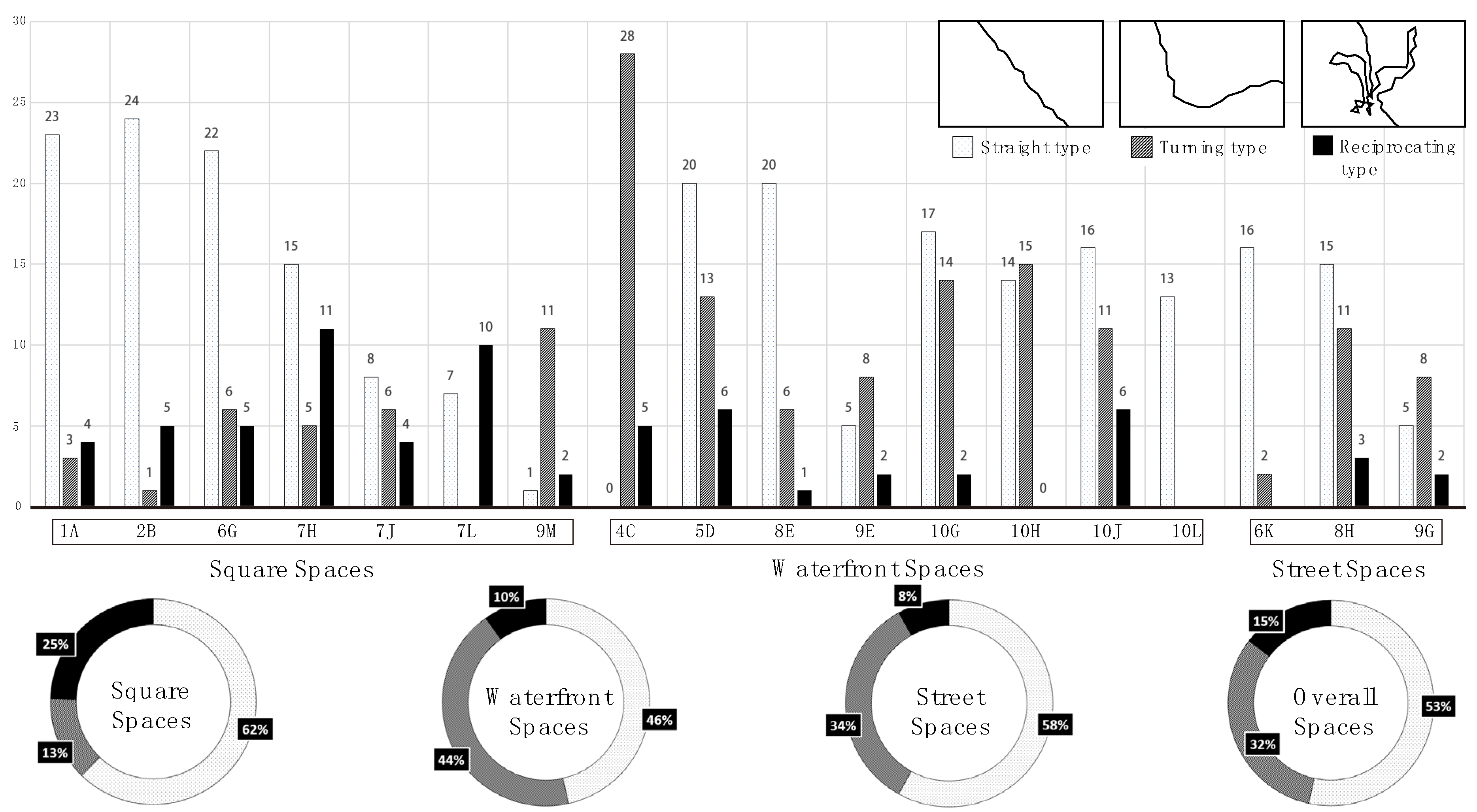
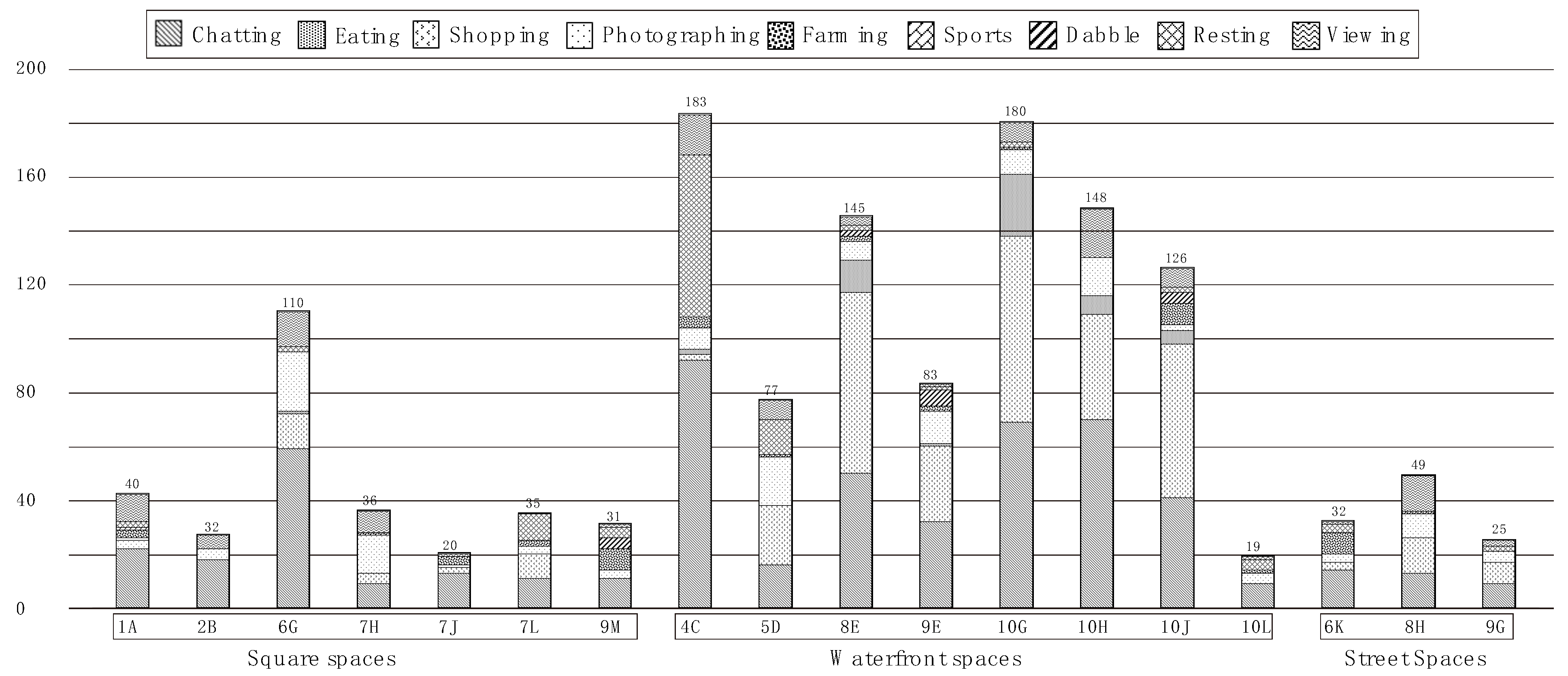
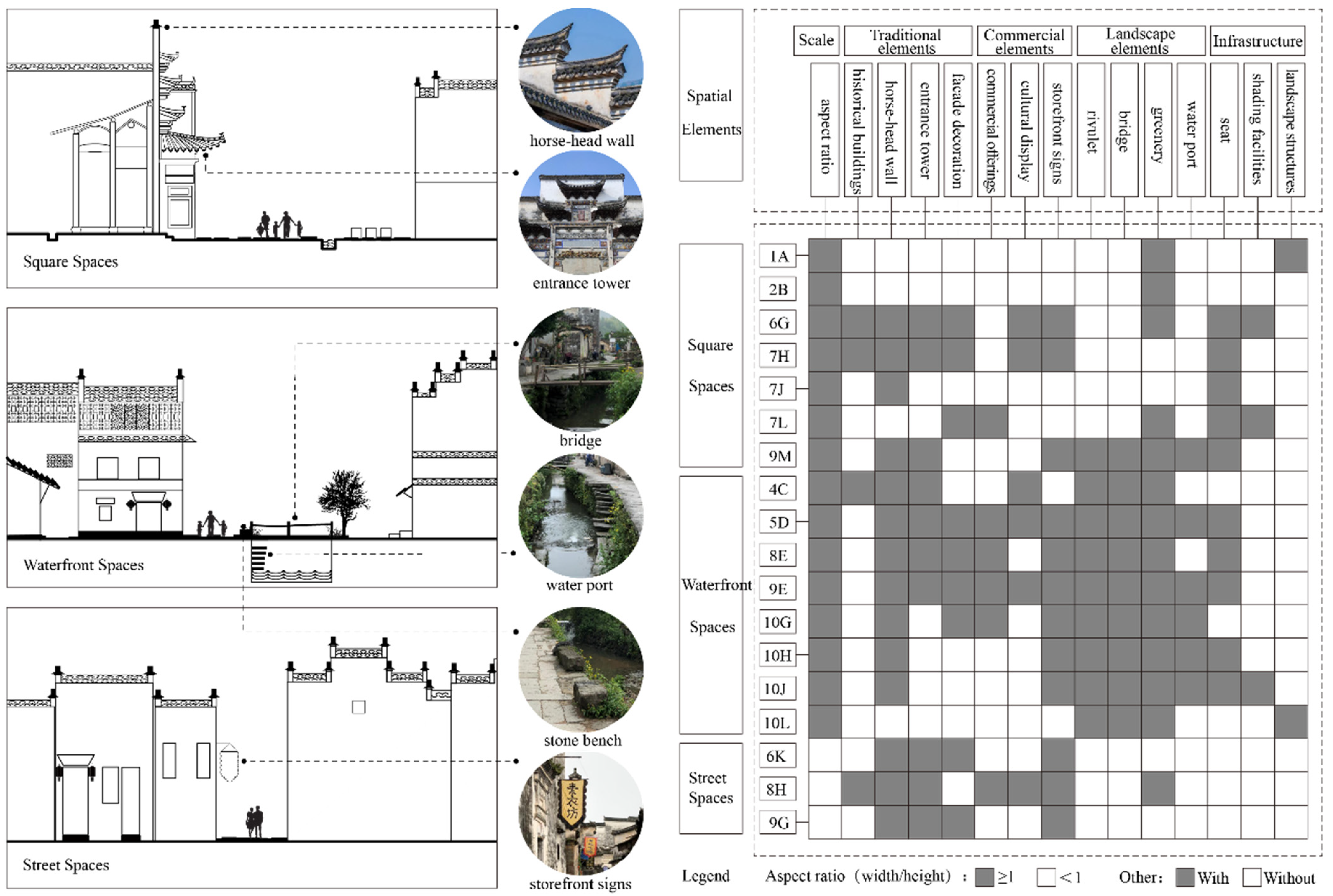

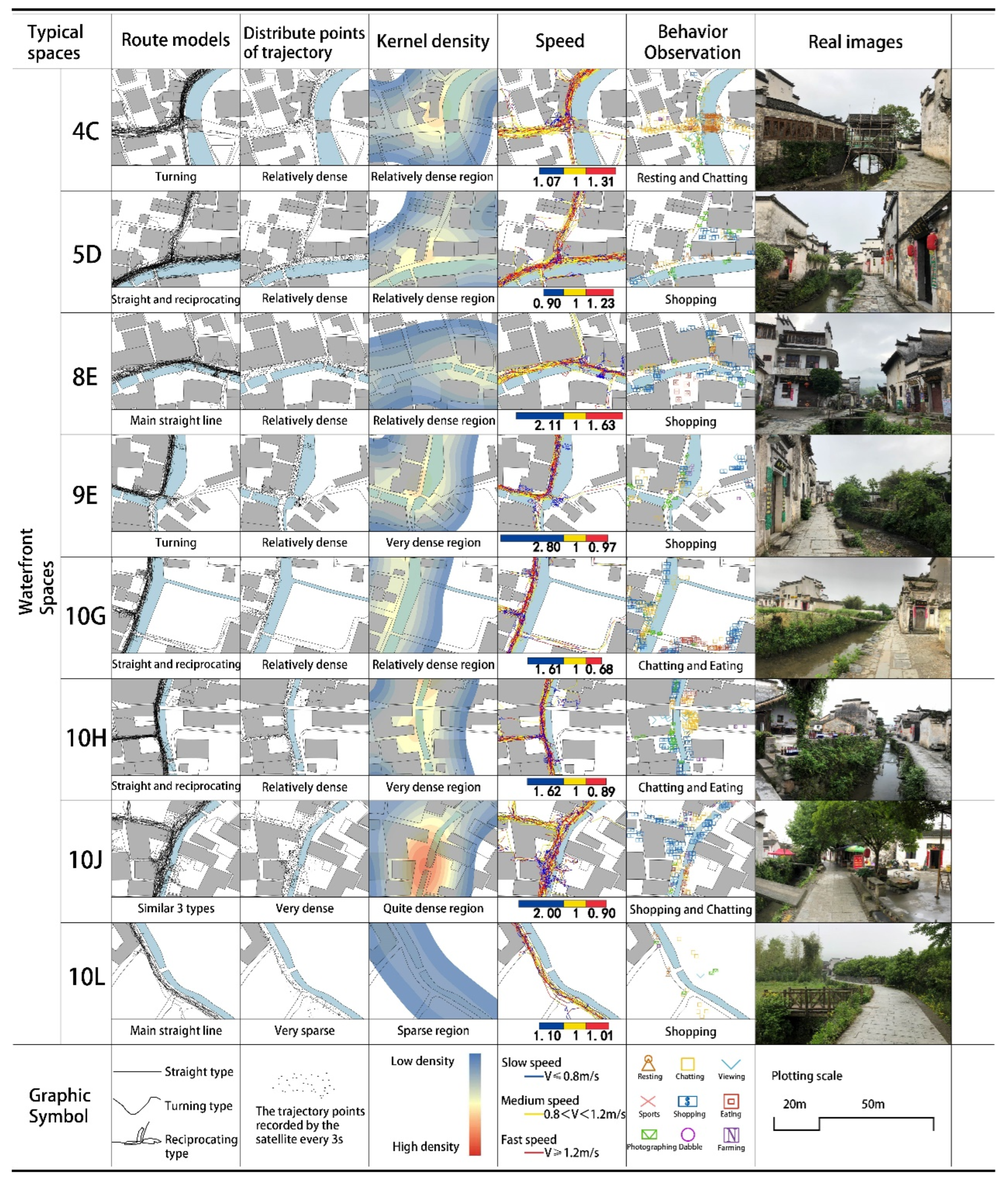
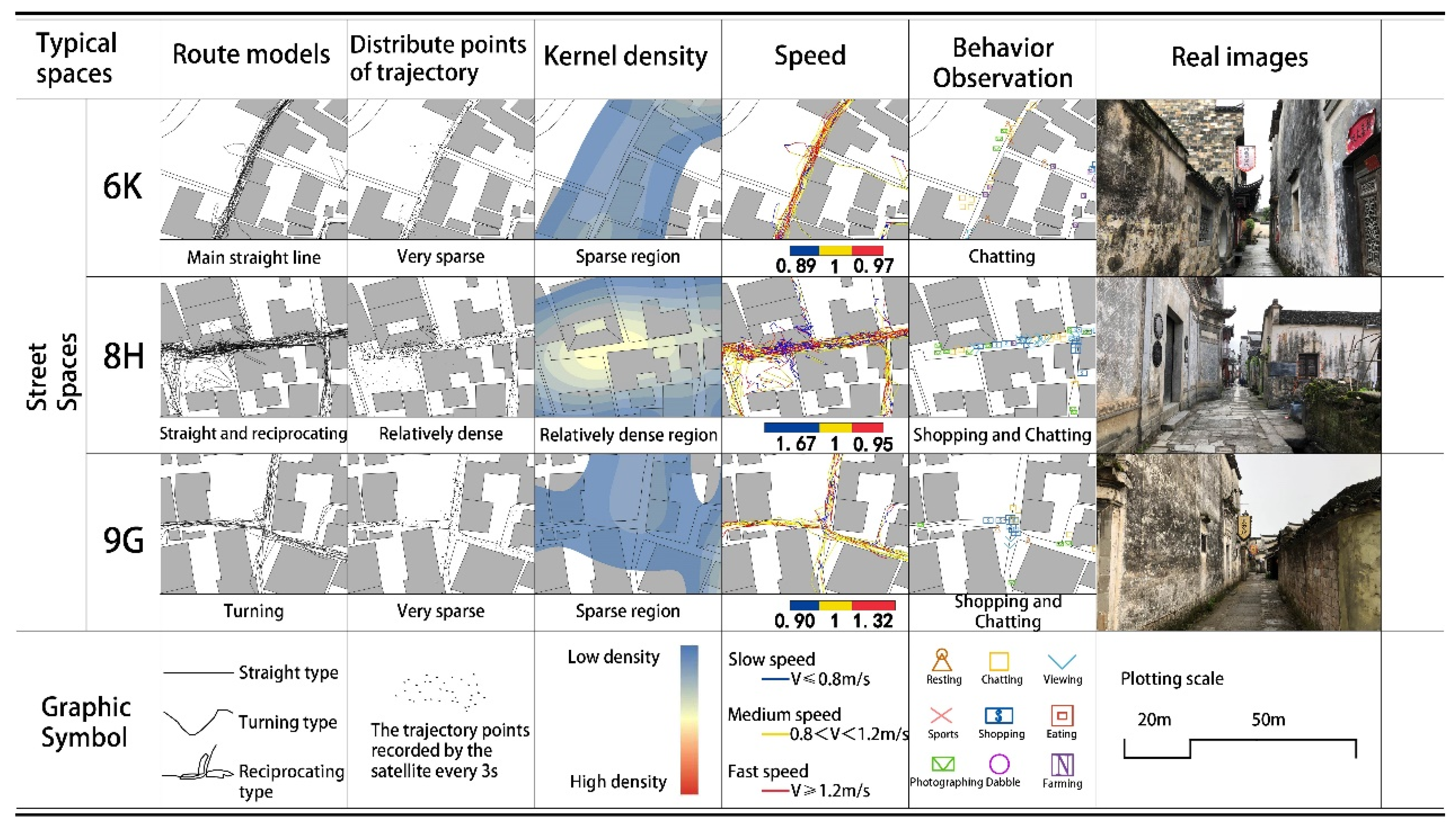
| Attributes | Population (%) | |
| Date of investigation | 26–29 March 2018 | |
| Weather | Cloudy 9 °C Southwest Wind Level III | |
| Investigation Period | 8:00–11:00, 15:00–18:00 | |
| Number of effective surveys | 38 (90.4) | |
| Gender | Male | 21 (55.3) |
| Female | 17 (44.7) | |
| Age | Adolescent (Under 44 years old) | 26 (68.4) |
| Middle age (45 years old to 59 years old) | 7 (18.4) | |
| The Old (over 60 years old) | 5 (13.2) | |
| Tourism style | Go with Companions | 29 (76.3) |
| Go alone | 9 (23.7) | |
Disclaimer/Publisher’s Note: The statements, opinions and data contained in all publications are solely those of the individual author(s) and contributor(s) and not of MDPI and/or the editor(s). MDPI and/or the editor(s) disclaim responsibility for any injury to people or property resulting from any ideas, methods, instructions or products referred to in the content. |
© 2023 by the authors. Licensee MDPI, Basel, Switzerland. This article is an open access article distributed under the terms and conditions of the Creative Commons Attribution (CC BY) license (https://creativecommons.org/licenses/by/4.0/).
Share and Cite
Gao, X.; Li, Z.; Sun, X. Relevance between Tourist Behavior and the Spatial Environment in Huizhou Traditional Villages—A Case Study of Pingshan Village, Yi County, China. Sustainability 2023, 15, 5016. https://doi.org/10.3390/su15065016
Gao X, Li Z, Sun X. Relevance between Tourist Behavior and the Spatial Environment in Huizhou Traditional Villages—A Case Study of Pingshan Village, Yi County, China. Sustainability. 2023; 15(6):5016. https://doi.org/10.3390/su15065016
Chicago/Turabian StyleGao, Xiang, Zao Li, and Xia Sun. 2023. "Relevance between Tourist Behavior and the Spatial Environment in Huizhou Traditional Villages—A Case Study of Pingshan Village, Yi County, China" Sustainability 15, no. 6: 5016. https://doi.org/10.3390/su15065016
APA StyleGao, X., Li, Z., & Sun, X. (2023). Relevance between Tourist Behavior and the Spatial Environment in Huizhou Traditional Villages—A Case Study of Pingshan Village, Yi County, China. Sustainability, 15(6), 5016. https://doi.org/10.3390/su15065016






